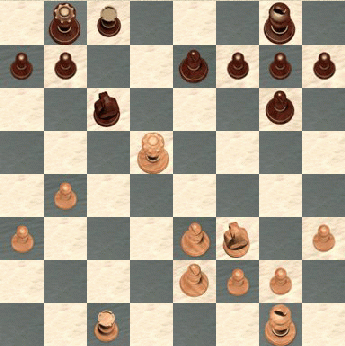1. e4,c5;
2. c3,d5;
3. exd5,Dxd5
4. d4,Nc6;
5. Nf3,cxd4;
6. cxd4,Bg4;
7. Be2,e6;
8. 0-0,Nf6;
9. h3,Bh5;
10. Nc3,Qd6;
11. Be3,Be7;
12. Qb3,
Everything along the very beaten path. Here the following options have
been tried to my knowledge:
(A) 12.a3!?,0-0; 13.Qb3 is an interesting option,
since it is likely to transpose to many of the main lines without allowing
black to play Qb4, that is often a freeing manouver in this game.
(B) 12.Qd2,0-0; and now:
(B1) 13.Bf4,Qd8; 14.a3,Bxf3; is a game Markovic-Atalik, Heraklio 1993;
(B2) 13.Rfd1,Rfd8; 14.Rac1,Rac8; 15.a3,Nd5; 16.b4,Nxe3; 17.Qxe3,Bxf3;
is Afek-Andrianov, Rishon le Zion 1993.
(C) 12.Rc1,0-0; 13.Nb5,Qd8; 14.Ne5,Bxe2; 15.Qxe2,Nb4; was a game
Handoko-Petursson, Dubai (ol) 1986.
(D) 12.Nb5, with two options:
(D1) 12....,Qb8; 13.Ne5,Bxe2; 14.Qxe2,0-0; 15.Nxc6,bxc6; 16.Nc3,Nd5;
17.Nxd5,cxd5; 18.Rac1,Qb6; with equality, Ljubojevic-Kasparov,
Moskov (ol) 1994;
(D2) 12....,Qd8; 13.Ne5,Bxe2; 14.Qxe2,Nb4; 15.d5,Nfxd5; 16.Bxa7,0-0;
17.Rfd1,Qa5; 18.a3,Nc6; 19.Bd4,Nf4; 20.Qf1,Nxd4; 21.Rxd4,Bf6; with a slight
edge for black, A.Ivanov-Petursson, Saint Martin 1991.
(E) 12.g4,Bg6; 13.Ne5, and now:
(E1) 13....,Nd5; 14.Nxd5,exd5; 15.Bf4,0-0; 16.Rc1,Qb4; 17.Nxc6,bxc6;
18.Qd2,Qb6; 19.a3,a5; 20.Rc3,Bf6; with unclear play, Blatny-Fominykh, Stary
Smokavec 1990;
(E2) 13....,0-0; 14.f4,Rad8; 15.Nxc6,bxc6; 16.Bf3,h6; 17.Rc1,Nd5;
18.Nxd5,cxd5; 19.Qa4,Qb8; with unclear play, Kharlov-Loginov, USSR (ch) 1991.
12. ...,0-0;
If instead 12....,Qb4; three main options are available to white:
(A) 13.Rfd1, and now:
(A1) 13....,0-0; 14.d5,Qxb3; 15.axb3,exd5; 16.Nxd5,Nxd5; 17.Rxd5,Bxf3;
18.Bxf3,Bf6; 19.Rd7, with advantage for white,
Okhotnik-F.Lengyel, Hayduboszormeny 1995;
(A2) 13.Qxb4,Bxb4; 14.g3,Bg6; 15.Ne5,0-0; 16.Nxc6,bxc6; 17.Rac1 was
Svesnikov-Hansen, Copenhagen 1984;
(A3) 13.g4,Bg6; 14.Ne5,0-0; 15.g5,Qxb3; 16.axb3,Nd5; 17.Nxd5,exd5;
18.Rfc1,Bf5; 19.Nxc6,bxc6; 20.Rxc6, with advantage for white, Sermek-Sher,
Bled 1993.
13.Rfd1,
Now also 13.a3!? is worth considering. Two main lines:
(A) 13....,a6?!; 14.Rfd1,Rfd8; 15.Rac1,b5; 16.d5!, and now
(A1) 16....,exd5; 17.g4! (not 17.Nxd5,Nxd5; 18.Rc5,Qe6; 19.Rcxd5,Rxd5;
20.Qxd5,Qxd5; 21.Rxd5,Bg6; 22.Nd4,Nxd4; draw agreed,
Cherniaev-Rausis, Gausdal 1995),Na5; 18.Qa2,Bg6; 19.g5!, see (A2);
(A2) 16....,Na5; 17.Qa2,Nxd5 (17....,exd5; 18.g4,Bg6; 19.g5!,Ne4;
20.Nxd5,Qe6; 21.Bb6,Bxg5; 22.Nxg5!,Nxg5; 23.Bg4 and white wins);
18.Nxd5,exd5; 19.Bc5 is slightly better for white.
(B) 13....,Rad8; 14.Rad1,Rd7; 15.Ne5,Bxe2; 16.Nxd7,Bxf1; 17.Nxf6+,Bxf6;
18.Ne4,Na5; 19.Nxd6,Nxb3; 20.Kxf1,Rd8; 21.Ne4,Be7; 22.Nc3,Bf6; 23.Ne4,Be7;
draw, Ivanovic-Miles, Niksic 1983.
13. ...,Rfd8;
14. a3,
On 14.Rac1, black may now play Qb4, which obtained advantage for black after
15.g4,Qxb3; 16.axb3,Bg6; 17.g5,Nd5; 18.Nxd5,Rxd5; 19.Bc4,Rf5!;
in Vorotnikov-Bahzin, Podolsk 1993. White has better play 15.Qxb4, which
brought to a balanced position in Estrada Gonsalez-Ljubojevic, France 1995.
14. ...,Rac8;
14....,Nd5!?; seems a good idea for black. Here white has two options:
(A) 15.Nxd5,Qxd5 (15....,exd5 lead to a quick draw in
Harley-P.Nunn, London 1996); 16.Qxd5,Rxd5; 17.g4,Bg6; 18.Bc4,Rdd8; 19.Ne5,Be4;
with a small edge for black, Bashkov-Schlosser, European Cup 1992;
(B) 15.Rac1,Rab8; 16.Nb5,Na5!; 17.Qc2,Bg6!; 18.Nxd6,Bxc2; 19.Rxc2,Bxd6;
with a drawish position, Kindermann-Babula, Moskov (ol) 1994.
15. Rac1,Qb8?!;
15....,Nd5; 16.Nxd5,Qxd5; is drawn according to John Nunn.
16. d5!, Nxd5;
17. Nxd5,exd5;
18. Rxd5,Rxd5N;
Curiously enough, this move has never been played before, though it's mentioned
in Murray Chandler's "The complete c3 Sicilian". The records give 18....,Bg6;
with the possible followup:
(A) 19.Rcd1,Rxd5; 20.Rxd5,Rd8; 21.Rxd8,Bxd8; 22.Qd5,Bf6; 23.b4,Qc7;
24.g4,h6 as in J.Van Mil-P.Kiss, Hungary 1992;
(B) 19.Rb5!,b6; 20.Rd5,Qb7! (but a game Nunn-Lutz went 20....,Bf6?;
21.Ba6,Ne7; 22.Rxc8,Rxc8; 23.Rd7 with advantage for white); 21.Rxd8+,Nxd8;
22.Rxc8,Qxc8; 23.Qa4,Nc6; 24.Ba6, with a slight advantage for white.
19. Qxd5,Bg6;
20. b4!,

20.Ne5?! looks attractive, but is not as strong as the text move, since black
equalizes quickly in the following
variation: 20....,Rd8 (if instead 20....,Nxe5; 21.Rxc8+,Qxc8; 22.Qxe5,Bf6;
23.Qa5,Bxb2; 24.Bg4,Qf8; 25.Qxa7, with a drawish position); 21.Nxc6,bxc6;
22.Qa2,Qe5; 23.Rxc6,Bd6; 24.g3,Qe8; 25.Qc4.
After 20.Nd4,Nxd4; 21.Rxc8+,Qxc8; 22.Qxd4 the position is again a dead draw.
The text move is good because white gets a freer position. According to
Fritz a possible variation is
20.b4!,Re8; 21.Nd4,Ne5; 22.Nb5,Nc6; 23.Bf3,Rd8; 24.Qb3,Qa8; 25.Bd5, and
white has a small advantage. Nevertheless, I was happy with a draw at this
point of the tournament, and my opponent is a very clean player in simple
positions as this one, so I offered a draw which he soon accepted.